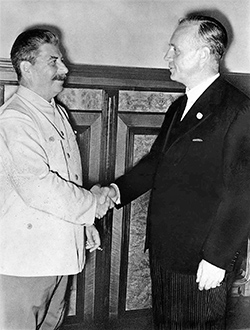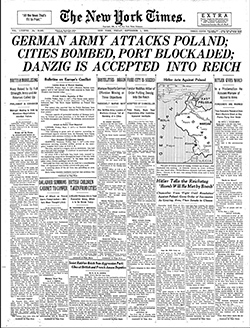MENU
The Electronic Scholarly Publishing Project: Providing access to classic scientific papers and other scholarly materials, since 1993. More About: ESP | OUR CONTENT | THIS WEBSITE | WHAT'S NEW | WHAT'S HOT
Comparative Timelines
The ESP Timeline (one of the site's most popular features) has been completely updated to allow the user to select (using the timeline controls above each column) different topics for the left and right sides of the display.
Select:
New Left Column
New Left Column
Dates
Decade
New Right Column
New Right Column
(no entry for this year)
1930
(no entry for this year)
(no entry for this year)
1931
(no entry for this year)
(no entry for this year)
1932
(no entry for this year)
(no entry for this year)
1933
 Franklin D. Roosevelt becomes thirty-second president of the United States.
Franklin D. Roosevelt becomes thirty-second president of the United States.
Adolf Hitler is appointed German Chancellor; later the same year he is granted dictatorial powers. Events are in motion that will lead to World War II — the greatest military struggle of all time.
(no entry for this year)
1934
 In Herndon vs Georgia, the United States Supreme Court sets aside the death sentence of black communist Angelo Herndon, who was convicted under a pre-Civil War slave insurrection statute for passing out leaflets in Atlanta.
In Herndon vs Georgia, the United States Supreme Court sets aside the death sentence of black communist Angelo Herndon, who was convicted under a pre-Civil War slave insurrection statute for passing out leaflets in Atlanta.
(no entry for this year)
1935
(no entry for this year)
(no entry for this year)
1936
 Track star Jesse Owens wins four gold medals at the Berlin Olympics between August 3 and August 9.
Track star Jesse Owens wins four gold medals at the Berlin Olympics between August 3 and August 9.
German troops occupy the Rhineland in defiance of the treaties of Locarno and Versailles.
(no entry for this year)
1937
(no entry for this year)
(no entry for this year)
1938
(no entry for this year)
(no entry for this year)
1939
 August 23, the Molotov–Ribbentrop Pact, officially the Treaty of Non-Aggression between Germany and the Union of Soviet Socialist Republics, and also known as the Hitler–Stalin Pact and the Nazi–Soviet Pact, was a non-aggression pact between Nazi Germany and the Soviet Union, with a secret protocol establishing Soviet and German spheres of influence across Northern Europe. The pact was signed in Moscow by Soviet Foreign Minister Vyacheslav Molotov and German Foreign Minister Joachim von Ribbentrop. One week after signing the pact, on 1 September 1939, Germany invaded Poland.
August 23, the Molotov–Ribbentrop Pact, officially the Treaty of Non-Aggression between Germany and the Union of Soviet Socialist Republics, and also known as the Hitler–Stalin Pact and the Nazi–Soviet Pact, was a non-aggression pact between Nazi Germany and the Soviet Union, with a secret protocol establishing Soviet and German spheres of influence across Northern Europe. The pact was signed in Moscow by Soviet Foreign Minister Vyacheslav Molotov and German Foreign Minister Joachim von Ribbentrop. One week after signing the pact, on 1 September 1939, Germany invaded Poland.
 September 1, Germany invades Poland; Britain and France declare war on Germany on September 3. Soviet troops invade Poland. World War II begins.
September 1, Germany invades Poland; Britain and France declare war on Germany on September 3. Soviet troops invade Poland. World War II begins.
 September 1, George C. Marshall is sworn in as Chief of Staff of the US Army. After the war, Churchill refers to Marshall (the only military leader to serve through the entirety of WW II) as the Architect of Victory for his crucial role in ensuring the defeat of the Axis Powers. The very day that Hitler launches all-out war in Europe, the man who will oversee his defeat takes command of the US Military — a military that, at the time, contained only 334,000 total personnel.
September 1, George C. Marshall is sworn in as Chief of Staff of the US Army. After the war, Churchill refers to Marshall (the only military leader to serve through the entirety of WW II) as the Architect of Victory for his crucial role in ensuring the defeat of the Axis Powers. The very day that Hitler launches all-out war in Europe, the man who will oversee his defeat takes command of the US Military — a military that, at the time, contained only 334,000 total personnel.
ESP Quick Facts
ESP Origins
In the early 1990's, Robert Robbins was a faculty member at Johns Hopkins, where he directed the informatics core of GDB — the human gene-mapping database of the international human genome project. To share papers with colleagues around the world, he set up a small paper-sharing section on his personal web page. This small project evolved into The Electronic Scholarly Publishing Project.
ESP Support
In 1995, Robbins became the VP/IT of the Fred Hutchinson Cancer Research Center in Seattle, WA. Soon after arriving in Seattle, Robbins secured funding, through the ELSI component of the US Human Genome Project, to create the original ESP.ORG web site, with the formal goal of providing free, world-wide access to the literature of classical genetics.
ESP Rationale
Although the methods of molecular biology can seem almost magical to the uninitiated, the original techniques of classical genetics are readily appreciated by one and all: cross individuals that differ in some inherited trait, collect all of the progeny, score their attributes, and propose mechanisms to explain the patterns of inheritance observed.
ESP Goal
In reading the early works of classical genetics, one is drawn, almost inexorably, into ever more complex models, until molecular explanations begin to seem both necessary and natural. At that point, the tools for understanding genome research are at hand. Assisting readers reach this point was the original goal of The Electronic Scholarly Publishing Project.
ESP Usage
Usage of the site grew rapidly and has remained high. Faculty began to use the site for their assigned readings. Other on-line publishers, ranging from The New York Times to Nature referenced ESP materials in their own publications. Nobel laureates (e.g., Joshua Lederberg) regularly used the site and even wrote to suggest changes and improvements.
ESP Content
When the site began, no journals were making their early content available in digital format. As a result, ESP was obliged to digitize classic literature before it could be made available. For many important papers — such as Mendel's original paper or the first genetic map — ESP had to produce entirely new typeset versions of the works, if they were to be available in a high-quality format.
ESP Help
Early support from the DOE component of the Human Genome Project was critically important for getting the ESP project on a firm foundation. Since that funding ended (nearly 20 years ago), the project has been operated as a purely volunteer effort. Anyone wishing to assist in these efforts should send an email to Robbins.
ESP Plans
With the development of methods for adding typeset side notes to PDF files, the ESP project now plans to add annotated versions of some classical papers to its holdings. We also plan to add new reference and pedagogical material. We have already started providing regularly updated, comprehensive bibliographies to the ESP.ORG site.
ESP Picks from Around the Web (updated 06 MAR 2017 )
Old Science

Weird Science

Treating Disease with Fecal Transplantation
Fossils of miniature humans (hobbits) discovered in Indonesia

Dinosaur tail, complete with feathers, found preserved in amber.
Astronomy

Mysterious fast radio burst (FRB) detected in the distant universe.